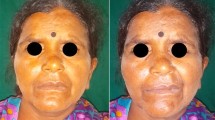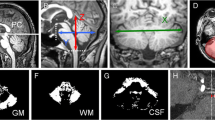Summary
The various hypotheses regarding the pathophysiologies of trigeminal neuralgia and hemifacial spasm are reviewed, and the results of recent physiological studies on the pathogenesis of hemifacial spasm are discussed. Evidence is presented that strongly supports the hypothesis that the symptoms and signs of hemifacial spasm are caused by hyperactivity in the facial motonucleus. Some of the contradictions regarding the prevalence of vascular conflicts in the cerebellopontine angle and the symptoms of vascular compression are discussed, and a hypothesis is presented that assumes that a suitable substrate must be present, in addition to vascular compression of the respective cranial nerve root, for the symptoms and signs of a cranial nerve vascular compression disorder to develop. Finally, it is discussed how this hypothesis can explain some of the differences between the disorders that can be cured by microvascular deompression of respective cranial nerves.
Similar content being viewed by others
References
Adams CBT (1989) Microvascular compression: An alternative view and hypothesis. J Neurosurg 57: 1–12
Auger RG, Piepgras DG, Laws Jr ER, Miller RH (1981) Microvascular decompression of the facial nerve for hemifacial spasm: Clinical and electrophysiologic observations. Neurology 31: 346–350
Bertrand RA, Molina P, Hardy J (1977) Vestibular syndrome and vascular anomaly in the cerebello-pontine angle. Acta Otolaryngol (Stockh) 83: 187–194
Burchiel KJ (1988) Carbamazepine inhibits spontaneous activity in experimental neuromas. Exp Neurol 102: 249–253
Calvin WH, Loeser JD, Howe JF (1977) A neurophysiological theory for the pain mechanism of tic douloureux. Pain 3: 147–154
Digre K, Corbett JJ (1988) Hemifacial spasm: Differential diagnosis mechanism and treatment. In: Tolosa E (ed) Advances in neurology, Vol. 39. Facial Dyskinesia. Raven Press, New York, pp 151–176
Esslen E (1957) Der Spasmus facialis eine Parabiosserscheinung: Elektrophysiologische Untersuchungen zum Entstehungsmechanismus des Facialisspasmus. Dtsch Z Nervenheil 176: 149–172
Esteban A, Molina-Negro P (1986) Primary hemifacial spasm: A neurophysiological study. J Neurol Neurosurg Psychiatry 49: 58–63
Ferguson JH (1978) Hemifacial spasm and the facial nucleus. Ann Neurol 4: 97–103
Fromm GH (1985) Effects of different classes of antiepileptic drugs on brainstem pathways. Fed Proc 44: 2432–2435
Fromm GH (1991) Pathophysiology of trigeminal neuralgia. In: Fromm GH, Sessle BJ (eds) Trigeminal neuralgia. Butterworth Heineman, Boston
Fromm GH, Chattha AS, Terrence CF, Class JD (1981) Role of inhibitory mechanism in trigeminal neuralgia. Neurology 31: 683–687
Gardner WJ (1962) Concerning the mechanism of trigeminal neuralgia and hemifacial spasm. J Neurosurg 19: 947–958
Gardner WJ, Sava GA (1962) Hemifacial spasm—a reversible pathophysiologic state. J Neurosurg 19: 240–247
Graeber MB, Kreutzberg GW (1988) Delayed astrocyte reaction following facial nerve axotomy. J Neurocytology 17: 209–220
Granit R, Skoglund CR, Leskell L (1944) Fiber interaction in injured or compressed region of nerve. Brain 67: 125–140
Hardy DG, Rhoton AL Jr (1978) Microsurgical relationship of the superior cerebellar artery and the trigeminal nerve. J Neurosurg 49: 669–678
Howe JF, Loeser JD, Calvin WH (1977) Mechanosensitivity of dorsal root ganglia and chronically injured axons: A physiological basis for the radicular pains of root compression. Pain 3: 25–41
Itagaki S, Saito S, Nakai O (1988) Intraoperative recording of evoked EMG in patients with hemifacial spasm-possible physiological mechanism. Facial N Res Jpn 8: 143–146
Itagaki S, Saito S, Nakai O (1989) Electrophysiological study on hemifacial spasm-usefulness in etiological diagnosis and pathophysiological mechanism. Brain and Nerve (Tokyo) 41: 1005–1011
Jannetta PJ, Hackett ER, Ruby JR (1970) Electromyographic and electron microscopic correlates in hemifacial spasm, treated by microsurgical relief of neurovascular compression. Surg Forum 21: 449–451
Kerr FWL, Miller RH (1966) The pathology of trigeminal neuralgia. Arch Neurol 15: 308–319
Kim P, Fukushima T (1984) Observations on synkinesis in patients with hemifacial spasm. J Neurosurg 60: 821–827
Kimura J (1983) Clinical uses of the electrically elicited blink reflex. In: Desmedt JE (eds) Motor control mechanisms in health and disease: new developments and clinical applications. Raven Press, New York, pp 773–786
Kugelberg E (1952) Facial reflexes. Brain 75: 385–396
Kumagami H (1974) Neuropathological findings of hemifacial spasm and trigeminal neuralgia. Arch Otolaryngol 99: 160–164
Matsushima T, Inoue T, Fukui M (1990) Arteries in contact with the cisternal portion of the facial nerve in autopsy cases: Microsurgical anatomy for neurovascular decompression surgery of hemifacial spasm. Surg Neurol 34: 87–93
Melita A, Trontelj J, Trontelj JV (1978) Reflex arc of the firt component of the human blink reflex: A single motoneurone study. J Neurol Neurosurg Psychiatry 41: 538–547
Møller AR (1987) Hemifacial spasm: Ephaptic transmission or hyperexcitability of the facial motor nucleus? Exp Neurol 98: 110–119
Møller AR (1991) Interaction between the blink reflex and abnormal muscle response in patients with hemifacial spasm: Results of intraoperative recordings. J Neurol Sci 101: 114–123
Møller MB (1990) Disabling positional vertigo. In: Myers EN, Bluestone CD, Brackmann DE, Krause CJ (eds) Advances in otolaryngology—head and neck surgery, Vol. 4. Mosby Year Book, Inc, Chicago, pp 81–106
Møller AR, Jannetta PJ (1984) On the origin of synkinesis in hemifacial spasm: Results of intracranial recordings. J Neurosurg 61: 569–576
Møller AR, Jannetta PJ (1985 a) Synkinesis in hemifacial spasm: Results of recording intracranially form the facial nerve. Experientia 41: 415–417
Møller AR, Jannetta PJ (1985 b) Microvascular decompression in hemifacial spasm: Intraoperative electrophysiological observations. Neurosurgery 16: 612–618
Møller AR, Jannetta PJ (1986 a) Blink reflex in patients with hemifacial spasm: Observations during microvascular decompression operations. J Neurol Sci 72: 171–182
Møller AR, Jannetta PJ (1986 b) Physiological abnormalities in hemifacial spasm studied during microvascular decompression operations. Exp Neurol 93: 584–600
Møller AR, Sen CN (1990) Recordings from the facial nucleus in the rat: Signs of abnormal facial muscle response. Exp Brain Res 91: 18–24
Møller MB, Møller AR (1985) Audiometric abnormalities in hemifacial spasm. Audiology 24: 396–405
Møller MB, Møller AR, Jannetta PJ, Sekhar LN (1986) Diagnosis and surgical treatment of disabling positional vertigo. J Neurosurg 64: 21–28
Moses H, Alexander GE (1982) Carbamazepine for hemifacial spasm. Neurology 32: 286–287
Nielsen VK (1984 a) Pathophysiological aspects of hemifacial spasm. Part I. Evidence of ectopic excitation and ephaptic transmission. Neurology 34: 418–426
Nielsen VK (1984 b) Pathophysiological aspects of hemifacial spasm. Part II. Lateral spread of the supraorbital nerve reflex. Neurology 34: 427–431
Nielsen VK, Jannetta PJ (1984) Pathophysiological aspects of hemifacial spasm. Part III. Effects of facial nerve decompression. Neurology 36: 891–897
Odkvist LM, Thell J, von Essen C (1988) Vestibulooculomotor disturbances in trigeminal neuralgia and hemifacial spasm. Acta Otolaryngol (Stockh) 105: 570–575
Ouaknine GE (1981) Microsurgical anatomy of the arterial loops in the ponto-cerebellar angle and the internal acoustic meatus. In: Samii M, Jannetta PJ (eds) The cranial nerves. Springer, Berlin Heidelberg New York, pp 378–390
Rasminsky M (1980) Ephaptic transmission between single nerve fibers in the spinal nerve roots of dystrophic mice. J Physiol (Lond) 305: 151–169
Ravits J, Hallert M (1986) Pathophysiology of hemifacial spasm. Localization of the lesion in hemifacial spasm. Letter to the Editor. Neurology 36: 591
Roth G, Magistris MR, Pinelli P, Rilliet B (1990) Cryptogenic hemifacial spasm. A neurophysiological study. Electromyogr Clin Neurophysiol 30: 361–370
Ruby JR, Jannetta PJ (1975) Hemifacial spasm: Ultrastructural changes in the facial nerve induced by neurovascular compression. Surg Neurol 4: 369–370
Saito S, Itagaki S, Nakai O (1990) Neurophysiological study on hemifacial spasm—the abnormality and origin of the electromyographic response to stimulation of the facial nerve. Brain and Nerve (Tokyo) 42: 621–627
Seltzer Z, Devor M (1979) Ephaptic transmission in chronically damaged peripheral nerves. Neurology 29: 1061–1064
Sen CN, Møller AR (1987) Signs of hemifacial spasm created by chronic periodic stimulation of the facial nerve in the rat. Exp Neurol 98; 336–349
Sunderland S (1948) Neurovascular relations and anomalies at the base of the brain. J Neurol Neurosurg Psychiatry 11: 243–257
Tanaka T, Yu H, Kitai ST (1971) Trigeminal and spinal inputs to the facial nucleus. Brain Res 33: 504–508
Thompson PD, Carroll WM (1983) Hemimasticatory spasm—a peripheral paroxysmal cranial neuropathy. J Neurol Neurosurg Psychiatry 46: 274–276
Valls-Sole J, Tolosa ES (1989) Blink reflex excitability cycle in hemifacial spasm. Neurology 39: 1061–1066
Wall PD (1977) The presence of ineffective synapses and the circumstances which unmask them. Philos Trans R Soc Lond Biol 278: 361–1372
Wartenberg R (1946) Associated movements in oculomotor and facial muscles. Arch Neurol Psychiatry 55: 439–488
Wartenberg R (1952) Hemifacial spasm. A clinical and pathophysiological study. University Park Press, New York
Williams HL, Lambert EH, Woltman HW (1952) The problem of synkinesis and contracture in cases of hemifacial spasm and Bell's palsy. Ann Otol Rhinol Laryngol 61: 850–870
Woltman HW, Williams HL, Lambert EH (1951) An attempt to relieve hemifacial spasm by neurolysis of the facial nerves. Mayo Clin Proc 26: 236–240
Author information
Authors and Affiliations
Rights and permissions
About this article
Cite this article
Møller, A.R. The cranial nerve vascular compression syndrome: II. A review of pathophysiology. Acta neurochir 113, 24–30 (1991). https://doi.org/10.1007/BF01402110
Issue Date:
DOI: https://doi.org/10.1007/BF01402110




